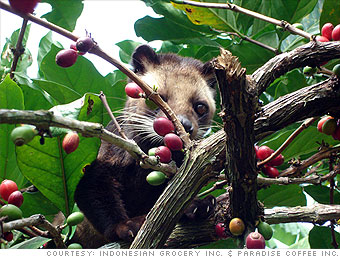I had started to write this post almost 3 weeks ago but then I kept thinking of more and more interesting aspects to coffee that I wanted to include and it started to become a bit too much. I'm returning to coffee on this foggy and cool Saturday morning and have decided that rather than create a flowing comprehensive post I'll pattern the entry off the name of this blog and post several random thoughts so here goes...
For the most part, I'm a one cup a day drinker. I'm not picky about the coffee I drink but one brand I rarely touch is Starbucks which has way too much caffeine for me. An 8 oz cup of Starbucks has 150 milligrams of caffeine compared to 95 milligrams in plain brewed cup of coffee. For a fascinating presentation on Starbucks and how it subconsciously manipulates its customers see the video below.
 My absolute favorite coffee is Blue Bottle Coffee, a micro-roaster based in Oakland, CA. you can order Blue Bottle online via their website. Here is a link to a recent article on Blue Bottle.
My absolute favorite coffee is Blue Bottle Coffee, a micro-roaster based in Oakland, CA. you can order Blue Bottle online via their website. Here is a link to a recent article on Blue Bottle. Kopi Luwak is one of the, if not the, most expensive coffee in the world. Why you ask? Well, this is a bit unappetizing but here goes...the palm civet, a cat-like animal also called a luwak, eats fresh coffee cherries but doesn't digest the beans inside. After the beans pass through the civet's system, the beans are collected from the civet poop (yep that's how it works) and they are then washed and roasted. Supposedly, the civet's digestive enzymes make the beans less acidic, improving the coffee's flavor.
Kopi Luwak is one of the, if not the, most expensive coffee in the world. Why you ask? Well, this is a bit unappetizing but here goes...the palm civet, a cat-like animal also called a luwak, eats fresh coffee cherries but doesn't digest the beans inside. After the beans pass through the civet's system, the beans are collected from the civet poop (yep that's how it works) and they are then washed and roasted. Supposedly, the civet's digestive enzymes make the beans less acidic, improving the coffee's flavor.I've never had civet poop coffee, I mean Kopi Luwak, before so I can't vouch for its...uhhh flavor. I've seen it on a menu once, at Silks Restaurant in the Mandarin Oriental Hotel in SF, but $40 for a cup of coffee was asking a bit much. If anyone has tried it let me know what you think.
 This past spring, while spending a wonderful weekend in Pt. Reyes celebrating my wife's birthday, I discovered in a local grocery store a "consciousness" coffee that I fully support. The coffee named, End the Embargo on Cuba, is produced by the Thanksgiving Coffee Company located in Mendocino, CA. The tag line on the coffee bag is great..."Not just a Cup But a just Cup".
This past spring, while spending a wonderful weekend in Pt. Reyes celebrating my wife's birthday, I discovered in a local grocery store a "consciousness" coffee that I fully support. The coffee named, End the Embargo on Cuba, is produced by the Thanksgiving Coffee Company located in Mendocino, CA. The tag line on the coffee bag is great..."Not just a Cup But a just Cup".A portion of the profits from every package of End The Embargo Coffee, which can be ordered online, is donated to the US-Cuba Sister Cities Association, a non-profit organization working to develop partnerships between US communities and their counterparts in Cuba.
 How caffeine works from ineedcoffee.com:
How caffeine works from ineedcoffee.com: Caffeine's stimulant action on the central nervous system is caused by its ability to block the brain's neuroreceptors for adenosine. Adenosine itself acts as a neuromodulator to produce behavioral sedation in several areas of the brain by inhibiting the release of neurotransmittors. By inhibiting adenosine's sedative effects, caffeine causes stimulation.
Low doses of about 200 mg of caffeine cause reduced drowsiness and fatigue in most individuals. The stimulant effect on skeletal muscles increases the body's ability to perform physically exhausting work for longer periods of time. The same dose of 200 mg keeps most people awake longer and causes sleep disturbances. Caffeine's stimulant qualities caused the National Academy of Sciences' Institute of Medicine to recommend ways to add caffeine to U.S. soldiers' rations. Since caffeine might give an athlete an unfair advantage, the U.S. Olympic Committee considers it a "performance enhancer", and regularly screens athletes for the drug.
 A recent NY Times article highlights the health benefits of coffee. Some interesting findings:
A recent NY Times article highlights the health benefits of coffee. Some interesting findings:- Women who drank one to three cups a day reduced their risk of cardiovascular disease by 24 percent;
- compared with people who do not drink coffee, those who do have half the risk of developing liver cancer;
- people who drank caffeinated coffee, but not decaf, had a 30 percent lower risk of Parkinson’s disease.
- compared with noncoffee drinkers, people who drank four to six cups of coffee a day, with or without caffeine, had a 28 percent lower risk of Type 2 diabetes.
No comments:
Post a Comment